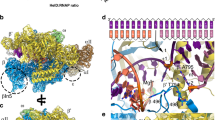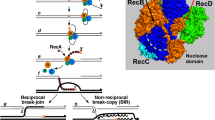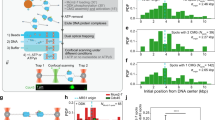Abstract
Helicases are molecular motors that move along and unwind double-stranded nucleic acids1. RecBCD enzyme is a complex helicase and nuclease, essential for the major pathway of homologous recombination and DNA repair in Escherichia coli2. It has sets of helicase motifs1 in both RecB and RecD, two of its three subunits. This rapid, highly processive enzyme unwinds DNA in an unusual manner: the 5′-ended strand forms a long single-stranded tail, whereas the 3′-ended strand forms an ever-growing single-stranded loop and short single-stranded tail. Here we show by electron microscopy of individual molecules that RecD is a fast helicase acting on the 5′-ended strand and RecB is a slow helicase acting on the 3′-ended strand on which the single-stranded loop accumulates. Mutational inactivation of the helicase domain in RecB or in RecD, or removal of the RecD subunit, altered the rates of unwinding or the types of structure produced, or both. This dual-helicase mechanism explains how the looped recombination intermediates are generated and may serve as a general model for highly processive travelling machines with two active motors, such as other helicases and kinesins.
This is a preview of subscription content, access via your institution
Access options
Subscribe to this journal
Receive 51 print issues and online access
$199.00 per year
only $3.90 per issue
Buy this article
- Purchase on Springer Link
- Instant access to full article PDF
Prices may be subject to local taxes which are calculated during checkout




Similar content being viewed by others
References
Lohman, T. M. & Bjornson, K. P. Mechanisms of helicase-catalyzed DNA unwinding. Annu. Rev. Biochem. 65, 169–214 (1996)
Smith, G. R. Homologous recombination near and far from DNA breaks: Alternative roles and contrasting views. Annu. Rev. Genet. 35, 243–274 (2001)
Taylor, A. & Smith, G. R. Unwinding and rewinding of DNA by the RecBC enzyme. Cell 22, 447–457 (1980)
Velankar, S. S., Soultanas, P., Dillingham, M. S., Subramaya, H. S. & Wigley, D. B. Crystal structures of complexes of PcrA DNA helicase with a DNA substrate indicate an inchworm mechanism. Cell 97, 75–84 (1999)
Phillips, R. J., Hickleton, D. C., Boehmer, P. E. & Emmerson, P. T. The RecB protein of Escherichia coli translocates along single-stranded DNA in the 3′ to 5′ direction: a proposed ratchet mechanism. Mol. Gen. Genet. 254, 319–329 (1997)
Chen, H.-W., Ruan, B., Yu, M., Wang, J.-d & Julin, D. A. The RecD subunit of the RecBCD enzyme from Escherichia coli is a single-stranded DNA dependent ATPase. J. Biol. Chem. 272, 10072–10079 (1997)
Dillingham, M. S., Spies, M. & Kowalczykowski, S. C. RecBCD enzyme is a bipolar DNA helicase. Nature 423, 893–897 (2003)
Chen, H.-W., Randle, D. E., Gabbidon, M. & Julin, D. A. Functions of the ATP hydrolysis subunits (RecB and RecD) in the nuclease reactions catalyzed by the RecBCD enzyme from Escherichia coli. J. Mol. Biol. 278, 89–104 (1998)
Sarasante, M., Sibbold, P. R. & Wittinghofer, A. The P-loop—a common motif in ATP- and GTP-binding proteins. Trends Biochem. Sci. 15, 430–434 (1990)
George, J. W., Brosh, R. M. Jr & Matson, S. W. A dominant negative allele of the Escherichia coli uvrD gene encoding DNA helicase II. A biochemical and genetic characterization. J. Mol. Biol. 229, 67–78 (1994)
Taylor, A. F. & Smith, G. R. Monomeric RecBCD enzyme binds and unwinds DNA. J. Biol. Chem. 270, 24451–24458 (1995)
Braedt, G. & Smith, G. R. Strand specificity of DNA unwinding by RecBCD enzyme. Proc. Natl Acad. Sci. USA 86, 871–875 (1989)
Korangy, F. & Julin, D. A. Efficiency of ATP hydrolysis and DNA unwinding by the RecBC enzyme from Escherichia coli. Biochemistry 33, 9552–9560 (1994)
Masterson, C. et al. Reconstitution of the activities of the RecBCD holoenzyme of Escherichia coli from the purified subunits. J. Biol. Chem. 267, 13564–13572 (1992)
Dohoney, K. M. & Gelles, J. χ-sequence recognition and DNA translocation by single RecBCD helicase/nuclease molecules. Nature 409, 370–374 (2001)
Bianco, P. R. et al. Processive translocation and DNA unwinding by individual RecBCD enzyme molecules. Nature 409, 374–378 (2001)
Dillingham, M. S., Wigley, D. B. & Webb, M. R. Direct measurements of single-stranded DNA translocation by PcrA helicase using the fluorescent base analogue 2-aminopurine. Biochemistry 41, 643–651 (2002)
Lee, M. S. & Marians, K. J. Differential ATP requirements distinguish the DNA translocation and DNA unwinding activities of the Escherichia coli PRI A protein. J. Biol. Chem. 265, 17078–17083 (1990)
Ganesan, S. & Smith, G. R. Strand-specific binding to duplex DNA ends by the subunits of Escherichia coli RecBCD enzyme. J. Mol. Biol. 229, 67–78 (1992)
Chaudhury, A. M. & Smith, G. R. A new class of Escherichia coli recBC mutants: Implications for the role of RecBC enzyme in homologous recombination. Proc. Natl Acad. Sci. USA 81, 7850–7854 (1984)
Yu, M., Souaya, J. & Julin, D. A. Identification of the nuclease active site in the multifunctional RecBCD enzyme by creation of a chimeric enzyme. J. Mol. Biol. 283, 797–808 (1998)
Korangy, F. & Julin, D. A. Enzymatic effects of a lysine-to-glutamine mutation in the ATP-binding consensus sequence in the RecD subunit of the RecBCD enzyme from Escherichia coli. J. Biol. Chem. 267, 1733–1740 (1992)
Hsieh, S. & Julin, D. A. Alteration by site-directed mutagenesis of the conserved lysine residue in the consensus ATP-binding sequence of the RecB protein of Escherichia coli. Nucleic Acids Res. 20, 5647–5653 (1992)
Anderson, D. G. & Kowalczykowski, S. C. The recombination hot spot χ is a regulatory element that switches the polarity of DNA degradation by the RecBCD enzyme. Genes Dev. 11, 571–581 (1997)
Bianco, P. R. & Kowalczykowski, S. C. The recombination hotspot χ is recognized by the translocating RecBCD enzyme as the single strand of DNA containing the sequence 5′-GCTGGTGG-3′. Proc. Natl Acad. Sci. USA 94, 6706–6711 (1997)
Anderson, D. G. & Kowalczykowski, S. C. The translocating RecBCD enzyme stimulates recombination by directing RecA protein onto ssDNA in a χ-regulated manner. Cell 90, 77–86 (1997)
Tomishige, M., Klopfenstein, D. R. & Vale, R. D. Conversion of Unc104/KIF1A kinesin into a processive motor after dimerization. Science 297, 2263–2267 (2002)
Ha, T. et al. Initiation and re-initiation of DNA unwinding by the Escherichia coli Rep helicase. Nature 419, 638–641 (2002)
Berneburg, M. & Lehmann, A. R. Xeroderma pigmentosum and related disorders: defects in DNA repair and transcription. Adv. Genet. 43, 71–102 (2001)
Boehmer, P. E. & Emmerson, P. T. Escherichia coli RecBCD enzyme: inducible overproduction and reconstitution of the ATP-dependent deoxyribonuclease from purified subunits. Gene 102, 1–6 (1991)
Acknowledgements
We thank D. Julin for advice on protein purification; M. Dillingham, M. Spies and S. Kowalczykowski for sharing their unpublished information7; S. Amundsen for permission to cite unpublished results; J. Cooper, M. Gellert, N. Maizels, R. Strong and our colleagues for comments on the manuscript; and L. Caldwell and staff for help with the electron microscopy. This research was supported by grants from the NIH.
Author information
Authors and Affiliations
Corresponding author
Ethics declarations
Competing interests
The authors declare that they have no competing financial interests.
Rights and permissions
About this article
Cite this article
Taylor, A., Smith, G. RecBCD enzyme is a DNA helicase with fast and slow motors of opposite polarity. Nature 423, 889–893 (2003). https://doi.org/10.1038/nature01674
Received:
Accepted:
Published:
Issue Date:
DOI: https://doi.org/10.1038/nature01674
This article is cited by
-
Auxiliary ATP binding sites support DNA unwinding by RecBCD
Nature Communications (2022)
-
Application of CRISPR/Cas System in the Metabolic Engineering of Small Molecules
Molecular Biotechnology (2021)
-
Chi hotspot control of RecBCD helicase-nuclease by long-range intramolecular signaling
Scientific Reports (2020)
-
Harnessing structural instability for cell durotaxis
Acta Mechanica Sinica (2019)
-
A 3′-5′ exonuclease activity embedded in the helicase core domain of Candida albicans Pif1 helicase
Scientific Reports (2017)
Comments
By submitting a comment you agree to abide by our Terms and Community Guidelines. If you find something abusive or that does not comply with our terms or guidelines please flag it as inappropriate.



